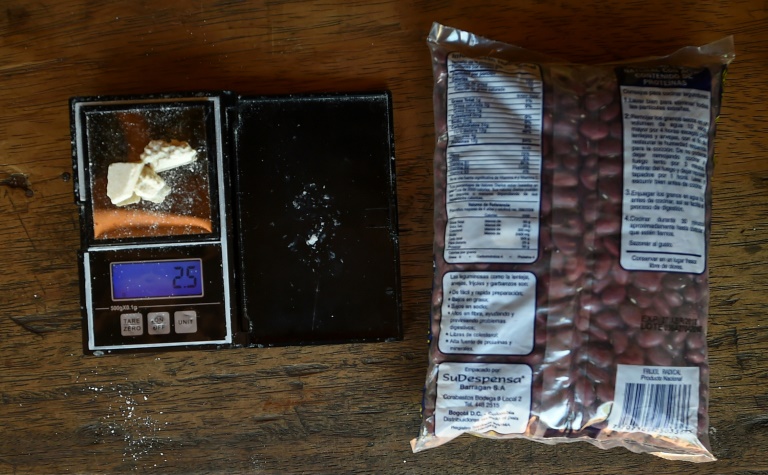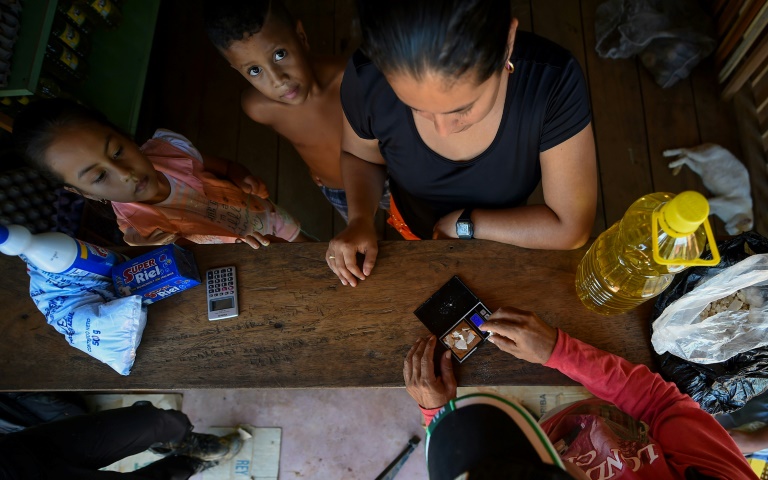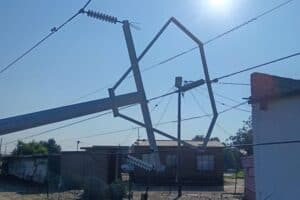Customers in Lorena's shop place innocuous white pebbles on an electronic scale. In exchange they take away staples like cooking oil and eggs - in the depths of the Colombian jungle, you pay with cocaine base paste.
“Everything is bought and sold this way. Cash is very rare and kept for emergencies,” said the 26-year-old woman, adding that in her lifetime, more white powder had passed through her hands than cash.
It’s the same whether locals are paying for beer or the company of a prostitute: coke — or in this case its raw material, coca paste — is king.
Lorena has lived in the tiny jungle village of La Paz for seven years, a hamlet of 300 souls whose reddish earth streets turn to mud in the rain. It lies on the banks of the Inirida River in the remote southeastern department of Guaviare, Colombia’s most underdeveloped region.

A customer buys beans and pays with cocaine base paste at a grocery store in La Paz, Guaviare department, Colombia
The lush greenery of the landscape lends itself to the production of the coca leaf, the basic ingredient of cocaine, of which Colombia, despite the efforts of the government and the United States, is the world’s largest producer.
There is no electricity here, no potable water, no doctor and no police. Authority is exercised by dissident FARC guerrillas who have rejected a historic peace deal to remain in the jungle.
“This is another Colombia. There is no health care, nothing. And there are seven-year-old children here who have never seen money,” said Orland Castilla, a 64-year-old local community leader.
– State guarantees –
The only links to the outside world for La Paz’s 300 souls are the river, one dirt road and two telephone lines. A loudspeaker announces incoming phone calls.
Everyone here owes their existence to the cultivation and processing of the coca leaf. Contrary to the end product, flown the classic route from grass airstrips in Colombia to Mexico and on to the United States, producing coca paste is far from lucrative.

For some shop owners in La Paz, Colombia, more white powder has passed through their hands than cash
The price of a gram of cocaine in the US is about $150. But for the producers here, the gram of coca paste never exceeds 2,000 pesos, or around 70 cents.
The state guarantees aid to those campesinos or farmers who will substitute coca for legal crops. Those who refuse have to sometimes face the consequences of police raids, leading to occasional clashes. A police officer was held for three days by campesinos after clashes on July 20 on the banks of the Inirida.
Under pressure from the United States, the main market for Colombia’s cocaine, Bogota plans to reclaim 100,000 hectares (250,000 acres) from coca cultivation this year, by force if necessary.
A hoped-for dividend on the December peace deal with FARC is that the former guerrilla movement will encourage a move to legal crops.
– Weakest link –
From first light on the farm of Miguel “Mangos”, laborers empty bags of freshly picked coca leaves in a makeshift jungle laboratory.
Miguel, 56, runs a garden trimmer through the leaves and then sprinkles a mixture of water and lime over them. It’s the beginning of a lengthy chemical process involving cement, fertilizer, gasoline, and acids to extract cocaine. The coca paste that emerges from the first rudimentary process in La Paz has a cocaine content of around 35 percent.
For every $1,000 he invests, he makes 1,200 dollars. It allows him to survive, he says.
“I have planted bananas, maize, cassava, but it is not profitable,” Miguel told AFP. To bring bananas to the market requires transport and he ends up trading at a loss because of the costs involved, he said.
“One kilo of coca, I can take it in my pocket,” he said.
“When people come to buy the merchandise, we do not ask who they are and where they are going,” said Diego Parra, a 50-year-old community leader.
Buyers make themselves scare when the army or police get involved and may not return for a long time. Then the campesinos venture out with the grams of coca to the city of San Jose, almost four hours away by car, risking arrest by the police.
“They tell us we are guerrillas or that we are drug traffickers,” said Cielo Rueda, 40.
“But we are the last link in the chain. In all of the drug business, we are the poorest.”






